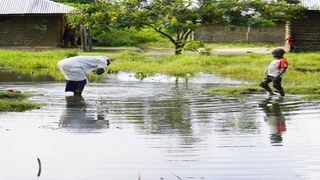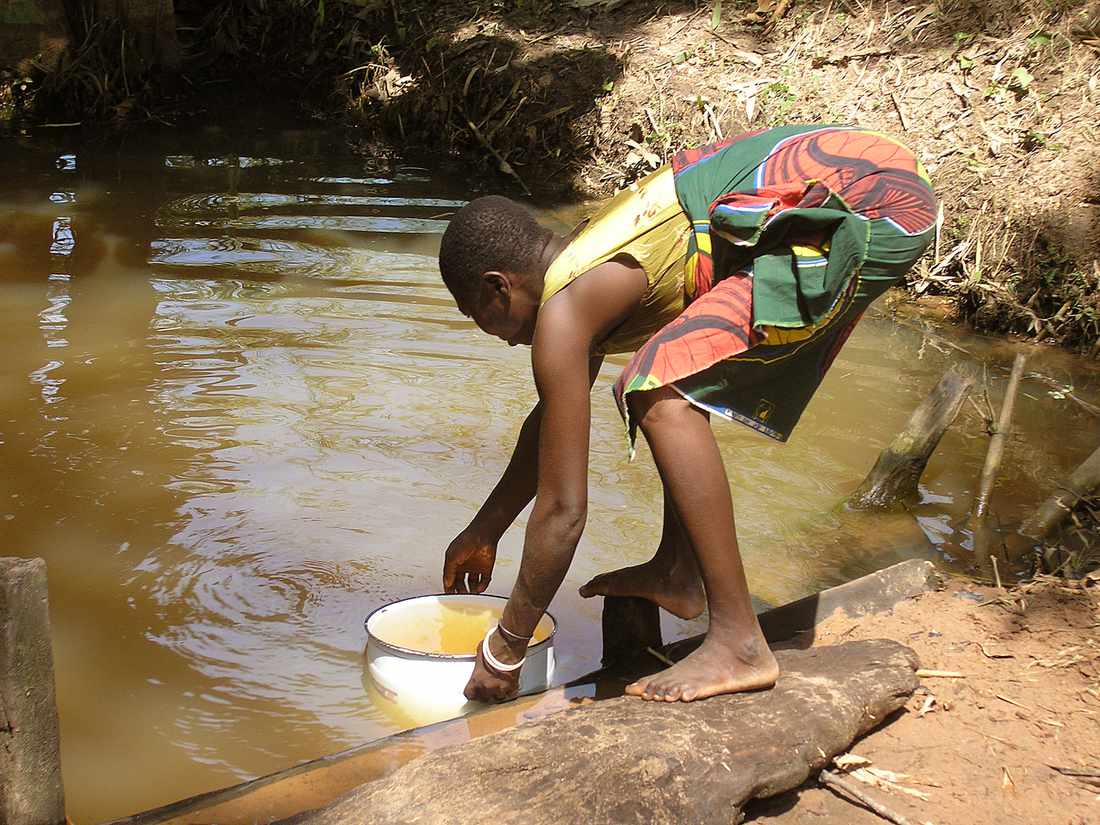
A man washes his face in a section of the swamp residents of Kilelengwani village in Tana River County use for domestic purposes.
| Stephen Oduor|Nation Media GroupTana River
Premium
The village where people are urinating blood
In a remote village in Tana River county, families are worried about a stubborn disease.
Children as young as seven in Kilelengwani village, Kipini East, are urinating blood and the elderly as old as 85 years confess to having lived with the same problem throughout their lives.
The disease, which health experts interviewed by Nation confirmed to be Schistosomiasis, also known as Bilharzia - is causing sleepless nights to the residents who say it has even affected childbearing in recent years.
Hassan Bawata, 51, says he has been battling Bilharzia since he was just nine years old.
"I woke up one day and went for a short call behind the house and while at it, I noticed my urine had a strange colour. It suddenly turned from colorless to red, so I told my mother about it," he narrated.

Hassan Bawata, a Bilharzia survivor from Kilelengwani Village, Tana River County narrates his experience.
Mr Bawata says his mother believed a demon had struck her child, and immediately put him on herbal medicines backing it up with a prayer from the Quran.
Villagers say, this is how they attended to the strange infection at the time since they assumed it was a calamity of the gods, as they lacked information about it.
"The herbal medicine was very bitter but was not helpful because all it did was clean the stomach but my urine colour did not change," he said.
At school, he opened up to his mates about his condition and to his surprise, they had it too. The fact that he was not alone in the misery consoled him and to some extent, made him believe it was a normal occurrence.
All the students confessed to each other that they were on herbal medicine and had been told the problem would go away with time. Little did they know their parents too had endured the same disease for years in the past.
At some point, they made a game out of it, trying to compare whose urine was redder than the other.
After years of struggling with the disease, Mr Bawata says he dropped out of school and his parents took him to the health centre in Ngao, more than 90 kilometres away for treatment.
"There were some white men there at the time, that was the only place we found help, some injection, and after a few days I saw the colour of my urine turning back to normal," he said.
Read More:
The pain went away, but that only lasted three years and he was back in the shackles of bilharzia. Despite treatment, the situation keeps on recurring.
Ms Nashehe Halako, is a frustrated mother of three.

Nashehe Halako, a Bilharzia survivor during an interview with Nation in Kilelengwani Village, Tana River County
"I have suffered with my children, it is disheartening that I should suffer all this while and now my children join the queue with the same problem," she said amid tears.
She says she has exhausted resources to get treatment.
The farmer notes that the disease has cost her a lot of money to travel to Witu health centre, 25 kilometres away to get her family in shape.
The disease causes patients to endure backaches, belly pains and pain when passing urine.
Ali Kimea, 85, who is an elder in the village notes that he has suffered the disease since he was 12 years old.

Ali Kimea, a village Elder in Kilelengwani, Tana River County says he also suffered from bilharzia when he was 12 years old.
He says that he has used various drugs, and got tested for the disease over the years, but there is no relief.
"This disease should be categorised in the same group as HIV/AIDS because you take drugs throughout the year else you are not safe," he said.
The village elder claims he has seen families being unable to reproduce like before and ladies being unable to bear children after contracting the disease.
Mr Kimea blames poor water quality, the mode of farming, and the lack of toilets in the area for the ever-prevailing problem.
"We have appealed to the county government to pipe water from the river Tana which is six kilometres from here, but they have ignored us all these years. They only come to this village during campaigns," he said.
He also notes that the lack of a well-equipped health centre and poor road network hampers efforts to help the residents get better.
The nearest health center in Kipini, 13 kilometres away, he says, is not helpful as it does not have a laboratory hence all residents turn to Witu Health Centre in Lamu County for proper treatment, which is costly.
Tana River County's Neglected Tropical Diseases Coordinator Joseph Ndegwa says that the disease is indeed a crisis in the county with more than 70 percent of the Population at risk of contracting bilharzia.
He says that out of 15 wards in the county, 13 are affected, with wards in Tana Delta and Tana River Sub Counties being the most affected.
"All Wards in Tana Delta are affected, and Kipini East is the most affected especially Kilelengwani and villages around it," he said.
Further, he notes that the Hola Referral Hospital attends to more than 2,800 cases of bilharzia every year.
Mr Ndegwa emphasizes the need for promotion of preventive measures across all the 13 wards but cites financial challenges.
"We need a lot of help and this may require more partners to come and help us end this crisis once and for all because we need to spread knowledge and also treat the affected," he said.
Schistosomiasis or Bilharzia, which the World Health Organisation (WHO) refers to as a disease of poverty is caused when people come into contact with fresh water infested with the larval forms of parasitic blood flukes known as schistosomes.
Symptoms begin to manifest within 1-2 months of infection and may include fever, cough, chills, and muscle aches when it goes without treatment for long. Symptoms such as abdominal pain, enlarged liver, blood in stool, blood in urine and pain during urination are common.
Bilharzia can cause infertility in women and men through hormonal imbalance, testicular tissue damage, and genital ductal system obstruction in men.
It can also cause erectile dysfunction and decreased libido due to associated hormonal imbalance and prostatic infestation.
Uterine enlargement, menstrual disorders, and cervicitis are also experienced in women as a result of bilharzia.
According to WHO, schistosomiasis in children can cause anaemia, stunting and a reduced ability to learn. The effects are usually reversible with treatment though re-infection can occur.





